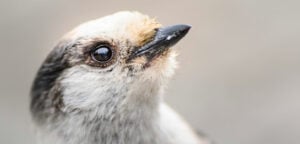
Wildlife
Excerpt from The Canada Jay as the National Bird of Canada
Editor-in-chief and associate publisher Aaron Kylie contributed this chapter to a compilation book about the Canada Jay
- 1532 words
- 7 minutes
This article is over 5 years old and may contain outdated information.
Wildlife

With 450 species in the country to choose from, Canadian Geographic’s decision was made neither lightly nor quickly.
This national debate has been running since January 2015, in fact. But after weighing the opinions and preferences of tens of thousands of Canadians, as well as the expertise of our National Conservation Partners at Bird Studies Canada and other ornithologists and conservationists, as well as cultural experts and Indigenous Peoples, that list was narrowed to five birds. And one finalist best met all reasonable criteria.
We give you the gray jay. Also known as the whiskey jack or Canada jay, it is Canadian Geographic’s official recommendation for National Bird of Canada.



Like the Canadian flag when it was selected in 1965, the gray jay is fresh and new and fitting. To quote David Bird, ornithologist and professor emeritus of wildlife biology at Montreal’s McGill University, we cannot think of a more Canadian bird.
Are you passionate about Canadian geography?
You can support Canadian Geographic in 3 ways:

Wildlife
Editor-in-chief and associate publisher Aaron Kylie contributed this chapter to a compilation book about the Canada Jay

Wildlife
Canada jays thrive in the cold. The life’s work of one biologist gives us clues as to how they’ll fare in a hotter world.

Travel
Spread your wings with birdwatching’s elite guard in south Texas

Wildlife
Largely unheralded until Canadian Geographic’s National Bird Project was held, the renamed Canada jay — formerly grey jay — has become in many minds the country’s national bird